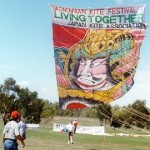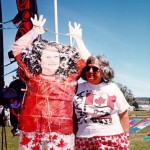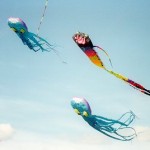Launceston, Tasmania, Australia
Ten years ago, in 1988, Australia’s first World Kiting Festival was held in Launceston as part of Australia’s bicentennial celebrations. (The Bicentenary celebrated the arrival of the First Fleet from England, consisting of eleven ships, into Sydney harbour on January 26 1788, founding the first European settlement in Australia.) This festival was highly acclaimed with kite fliers from around the world, acknowledging it as one of the finest ever held.
Following repeated requests from kite fliers in Australia and overseas, the organisers of the original event, led by Jeremy Carson, decided to hold another festival. So the Roaring Forties International Kite Festival was born, and after many months of planning and organisation hit the skies of Launceston and once again presented the magic and excitement of kites to thousands of school children and visitors over the 4 day event.
For those of you not familiar with Tasmania, it is Australia’s island State and mostly lies between 40 and 44 south latitudes, right in the path of the legendary Roaring Forties winds. These were the winds that brought white settlers to Australia and continued to guide the ships provisioning the Australian white settlements throughout the early days of colonization. Tasmania is world renowned for its awareness and commitment to a clean and green environment.
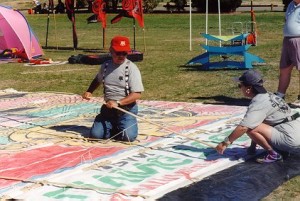 At the last international kite festival in Launceston, Masaaki Modegi and his contingent of fliers from the Japanese Kite Association left a huge Edo kite as a gift to the city. Over the years, there has been a bit of wear and tear on the kite which is approximately 7metres x 5metres and made of washi paper and bamboo. Local kite fliers in Tasmania undertook restoration of this kite to ready it for another flight at the current festival. Masaaki Modegi came again this year to witness the resurrection of his Edo kite, and to supervise the flying of the large festival Edo once again. [photo: KS]
At the last international kite festival in Launceston, Masaaki Modegi and his contingent of fliers from the Japanese Kite Association left a huge Edo kite as a gift to the city. Over the years, there has been a bit of wear and tear on the kite which is approximately 7metres x 5metres and made of washi paper and bamboo. Local kite fliers in Tasmania undertook restoration of this kite to ready it for another flight at the current festival. Masaaki Modegi came again this year to witness the resurrection of his Edo kite, and to supervise the flying of the large festival Edo once again. [photo: KS]
A new festival kite was made this year by Tasmanian kite maker Robert Brassington, and an official launching and flying of this kite was officiated by the Premier of Tasmania on the Saturday afternoon of the festival. [photo: KS]
Other international guests at the festival included Shakib Gunn (Singapore) (below left), David Gomberg (USA) (below right), Peter Lynn (NZ), Roe Sung Kyu and Kang Bum Ku (Korea), Abdul Halim and Siti Hasnah (Malaysia), Elain Genser (Canada)(below center), David and Muriel Bowie (NZ). There were a host of kite fliers from Australia including Michael Alvares, Tony Rice, Rob and Tracey Brassington, Michael Richards, John Murray, Peter Stauffer, Peter Batchelor and Bob Dawson to name just a few. [photo: PB]
All kite fliers were greeted on arrival at Launceston airport by the ever punctual and convivial bus driver John Campbell whose job it was to ferry the kite fliers to and from the flying site each day and to most of the social functions arranged at nights. Nothing was too much trouble for John who made tremendous efforts to transport the kite fliers around Launceston.
Four workshops were run during the festival. Michael Alvares ran a workshop on building lantern kites for nite flying, Tony Rice conducted a kite fliers colour and design workshop. Michael Richards ran a stunt flying workshop and on-field clinic, and David Gomberg ran a Rokkaku kite fighting session. [photos below, L-R: PB / GP / KS]
Two serious competitions were held during the festival, a rokkaku battle and a fighter kite competition. The rokkaku battle, held over 3 rounds, was eventually won by Tony Rice and John Murray flying one of the sponsor’s kites, while Dave Gomberg, teamed with South Australian Kevin Sanders came a very close second. The fighter kite competition ended in an enthralling final between Abdul Halim of Malaysia and Roe Sung Kyu of Korea, with Halim being the eventual winner in the third and deciding round. This was my first exposure to fighter kite competition and I was in awe of the skill of these fighter kite pilots. Traditional manja kite line was used in the battle, however, due to aviation restrictions, the combatants were limited to flying at under 300 m height. Despite this both contestants put on a truly magical display offighter kite flying.
Bob Dawson introduced a new stunt kite competition specifically aimed at getting the public more involved and interested in stunt competition, called Grand Prix / Time Trial Competition. Bob is a masters class stunt kite pilot and the leading judge in Australia at the moment, and was a judge at the last World Cup in Long Beach, USA, in 1997. In Bob’s words, “This is an attempt to bring back the fun into sport kite competition. It seems to me that the competition under STACK and AKA has become too serious and has too many possibilities for disagreement between judges. The precision event leaves no chance for the audience to participate on an emotional level. This is an attempt to get the audience to participate on an emotional level with the flier.”
Bob’s new Stunt Kite Grand Prix involves some simple rules, props and a simple scoring system. The event is explained to the audience so they know what is expected of the kite flier. The rules were something like this: The flier is timed over a circuit doing mandatory landings, dog stake flying and knocking pins off a pedestal. In addition, points can be gained for doing non-compulsory tricks, e.g., axels, turtles, wing-tips stands, etc. The event is commentated and the audience encouraged to get involved by barracking and cheering. The emphasis is on fun and simplicity.
I was one of the competitors in this event and my impression was that the crowd easily understood the requirements of the competition and seemed to enjoy it. The best part was while Bob was giving his performance. Somehow he had a bucket ‘dropped’ over his head by a fellow competitor. Bob, non-plussed, immediately stalled his kite, executed two axels, one in either direction, then flew his kite about in figure eights for a while. He had obviously practiced this quite often before… or is used to flying blind ! During the festival Bob Dawson also put on some amazing displays of flying two dual line stunt kites, one in each hand to music … ala Ray Bethell.
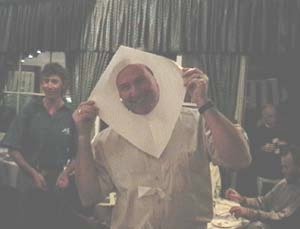 The organisation of the festival was a credit to the festival committee with most kite flier requests being dealt with promptly and efficiently. Social functions were well organised and attended. Friday night was the ‘Getting to know you Dinner’ held at picturesque Cataract Gorge restaurant where guests were given a twilight cable chair ride across the beautiful gorge to the restaurant. Fun and games were the theme of the night, and novelty kite making competitions were held. The best effort of the night just had to be Dave Gomberg’s entry for the Cutest Kite competition …. the photo it says it all ! Yes, that is Dave’s “cute” face applied to the skin of his hastily made kite! On Sunday night, there was a ‘home hospitality’ night where kite fliers were split into three separate groups and invited to homes of local residents; 2 of the 3 were not even kite fliers. Every one of the kite fliers raved about the quality of the hospitality night, each outdoing each other with tales of delightful food and drinks thrust upon them by their gracious hosts. [photo: PB]
The organisation of the festival was a credit to the festival committee with most kite flier requests being dealt with promptly and efficiently. Social functions were well organised and attended. Friday night was the ‘Getting to know you Dinner’ held at picturesque Cataract Gorge restaurant where guests were given a twilight cable chair ride across the beautiful gorge to the restaurant. Fun and games were the theme of the night, and novelty kite making competitions were held. The best effort of the night just had to be Dave Gomberg’s entry for the Cutest Kite competition …. the photo it says it all ! Yes, that is Dave’s “cute” face applied to the skin of his hastily made kite! On Sunday night, there was a ‘home hospitality’ night where kite fliers were split into three separate groups and invited to homes of local residents; 2 of the 3 were not even kite fliers. Every one of the kite fliers raved about the quality of the hospitality night, each outdoing each other with tales of delightful food and drinks thrust upon them by their gracious hosts. [photo: PB]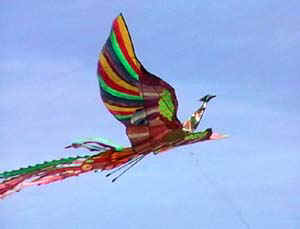 While the weather remained fine throughout the four days of the festival with temperatures around the mid to upper 20’s, wind conditions varied from no wind to strong wind throughout. The kite fliers handled it well and all worked hard to entertain the crowds in whatever conditions presented themselves. Unfortunately, wind gusts claimed a few kite victims, the worst that of the beautiful Phoenix kite (photo left) brought across by the Korean fliers. This kite broke loose and ended up in the nearby river system. Great efforts were made by the organisers to retrieve the kite including the use of boats and plane to locate it. The Phoenix was eventually recovered almost 24 hours later, but in a sorry and sore condition. [photo: PB]
While the weather remained fine throughout the four days of the festival with temperatures around the mid to upper 20’s, wind conditions varied from no wind to strong wind throughout. The kite fliers handled it well and all worked hard to entertain the crowds in whatever conditions presented themselves. Unfortunately, wind gusts claimed a few kite victims, the worst that of the beautiful Phoenix kite (photo left) brought across by the Korean fliers. This kite broke loose and ended up in the nearby river system. Great efforts were made by the organisers to retrieve the kite including the use of boats and plane to locate it. The Phoenix was eventually recovered almost 24 hours later, but in a sorry and sore condition. [photo: PB]
Other highlights of the festival included the large Peter Lynn kites , Peter’s Buggying demonstrations , rftas22.jpg (21982 bytes)Terry Chatfield’s no wind dual line ballet demonstrations, entertaining the crowds when nothing else would fly, Rob Brassington’s amazing box kites, Dave Gomberg’s Rokkaku battle tactics (nothing much to say about this), Elain Genser’s portrait kites, the Korean Phoenix kite, the flying of the Festival Edo kite and the traditional joget dance performed by the Malaysian (below: second row, left photo) contingent and friends holding aloft wau bulan kites . It was also a pleasure to have Shakib Gunn as the festival (below: right photo, first row) announcer, Shakib worked tirelessly to inform and entertain the crowd and kite fliers with his many stories, enormous knowledge of kites and wide range of music.
The best part of the festival was the opportunity to bring the joy of kites and kite flying to the school children and people of Launceston, and for me personally to meet old friends and make a lot more new friends. [photos above, clockwise from top left: PB / KS / GP / KS / KS] More photos of the event can be viewed at http://www.srl.rmit….ies/index.html#
Graeme Poole
Photo Credits: Graeme Poole, Kevin Sanders, Peter Batchelor


